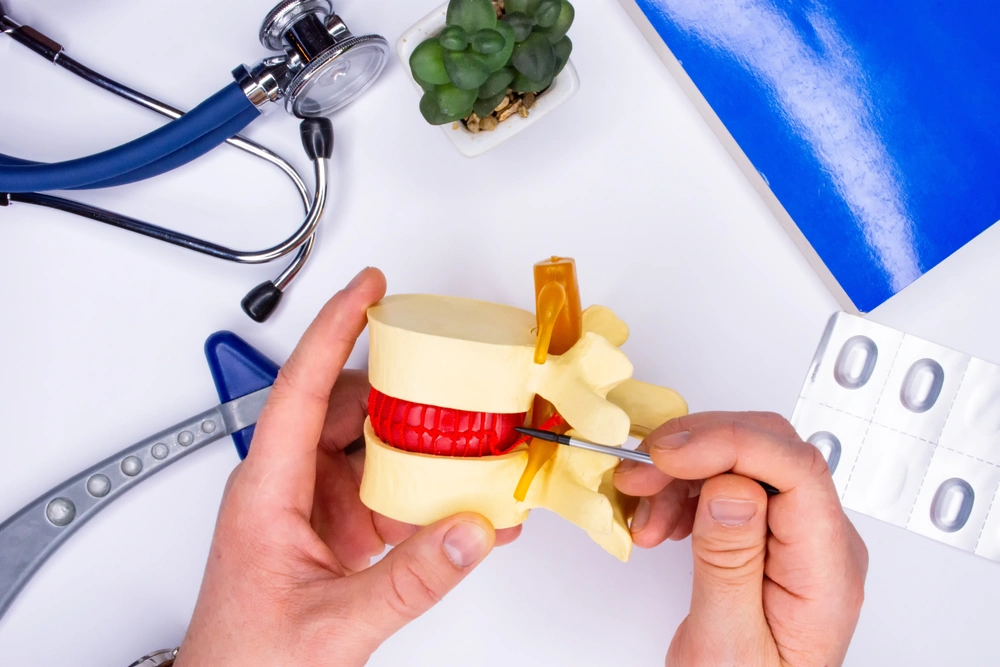Radiculopathy is a term used to describe a medical disorder in which one or more nerve roots are damaged or irritated, usually in the spinal area. Depending on which nerves are affected, this illness can provide pain, weakness, numbness, or tingling feelings in various places of the body.
A herniated disc, which occurs when the soft tissue inside the disc pushes out through a fracture in the hard outer layer and compresses a nearby nerve root, is the most typical cause of radiculopathy. A spinal tumor, degenerative disc degeneration, or spinal stenosis are among more potential causes.
What are the symptoms?
The severity of radiculopathy symptoms varies depending on which nerves are affected. The following are typical signs of radiculopathy:
Pain: is a common symptom of radiculopathy and is typically felt in the body part that the damaged nerve supplies. Sharp, shooting, burning, or dull pain are all possible.
Numbness or tingling: Radiculopathy can cause numbness or tingling in the area of the body supplied by the affected nerve. The sensation is often described as “pins and needles.”
Weakness: When the nerves that control muscles are affected, radiculopathy can cause weakness in the affected area. This can make it difficult to lift or move the affected body part.
Loss of reflexes: Radiculopathy can also cause a loss of reflexes in the affected area. This means that the affected muscles may not respond normally to certain stimuli, such as a tap on the knee.
Coordination issues: Radiculopathy can occasionally lead to issues with coordination, making it challenging to carry out fine motor tasks or maintain balance.
What is the treatment for radiculopathy?
The severity of the symptoms and the underlying cause of the condition both affect how radiculopathy is treated.
As often seen in medicine, the first line of action is always the least invasive, physiotherapy is indicated for the treatment along with medication. Only in severe cases the surgical option is the first.
Treatment for acute radicular pain, in the absence of neurologic deficit, begins with nonoperative management including physiotherapy, medication, and injections. Nonoperative management is effective for acute radicular pain in approximately 70-85% of cases at an average of 4-6 weeks.
Physiotherapy: Physiotherapy can help reduce pain, increase mobility and strength, and avoid a recurrence of the condition. It is a very effective treatment for radiculopathy.
The following are some typical physiotherapy procedures for radiculopathy:
Exercise therapy is often advised to help in increasing strength, flexibility, and mobility. Stretching, strengthening, and aerobic exercises may be included in a specialized workout regimen that is adapted to the demands and conditions of the individual.
Manual therapy: This type of treatment uses hands-on methods to help patients move more freely and experience less pain, such as joint mobilization, soft tissue massage, and spine manipulation.
Electrical stimulation: This technique includes stimulating the afflicted nerve with electrical currents to reduce pain and inflammation.
Heat or cold therapy: Applying heat or cold to a region can help with circulation, pain relief, and the reduction of swelling and inflammation.
Postural education: This type of physiotherapy educates patients in good body mechanics and posture to reduce stress on the musculoskeletal system and the injured nerve root. Maintaining good posture can help prevent or lower the risk of injury, pain, and musculoskeletal problems. It is also essential to preserving balance and stability.
TENS (Transcutaneous Electrical Nerve Stimulation): This form of electrical stimulation therapy uses tiny electrodes applied to the skin to deliver a low-voltage electrical current to the injured nerve to assist reduce pain.
Ultrasound therapy: This treatment uses high-frequency sound waves to treat the affected area’s inflammation and speed up healing.
Tecar Therapy: There aren’t currently enough publications and studies that show it to be helpful for this type of condition. Although it is still used as a pain management therapy for the alleviation of symptoms.
Medication: Nonsteroidal anti-inflammatory medicines (NSAIDs) or acetaminophen, both of which are available over-the-counter, may be recommended to treat pain and inflammation. Sometimes, stronger prescription medications like opioid painkillers or muscle relaxants may be required.
Epidural steroid injections: To reduce swelling and alleviate the pain, these injections deliver potent anti-inflammatory drugs right to the affected area.
Surgery: Surgery for lumbar radiculopathy is considered in several scenarios: 1) when nonoperative management of radicular pain fails to improve symptoms after 6+ weeks, 2) if there is acute and/or progressive motor deficit, and 3) pain is so severe and debilitating that nonoperative management is not possible. The appropriate surgical intervention depends primarily on the location and the source of nerve root compression/irritation.
It is important to remember that the type of physiotherapy suggested will depend on the needs and specific condition of the patient. It is always advised to consult a qualified physical therapist who can do a complete evaluation and develop an individualized treatment plan.
